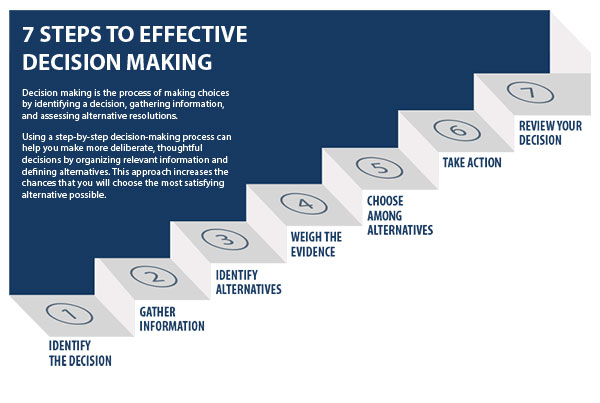Decision-making

Overview of Decision-making
Definition: the process of selecting a course of action among alternatives.
Decision-making is the mental process through which individuals or groups identify a problem, consider possible paths, and choose a course of action that seems best given the information available. It combines reasoning, judgment, and preferences to move from uncertainty to action.
Key elements: problem framing, criteria, options, consequences, and choice.
Effective decision-making starts with framing the problem clearly. Criteria define what matters, such as goals, constraints, and trade-offs. Options are the viable alternatives, followed by an assessment of potential consequences. The final choice reflects an evaluation against the criteria and anticipated outcomes.
Why it matters: impacts personal, professional, and policy outcomes.
On a personal level, decisions shape daily routines, risks, and long-term well-being. Professionally, they affect performance, resource use, and stakeholder trust. At the policy level, decisions influence equity, efficiency, and the public good, underscoring the need for transparency and accountability.
Decision-making Frameworks
Rational decision-making model: define the problem, generate alternatives, evaluate, and select.
The rational model describes a deliberate sequence: articulate the problem, brainstorm a wide range of alternatives, assess each option against objective criteria, and select the option that best satisfies the defined goals. It assumes access to complete information and stable preferences, which is rarely the case in practice but provides a useful benchmark for systematic thinking.
Bounded rationality and satisficing: practical limits on information and time.
In real-world settings, decision-makers face limits on time, cognitive capacity, and data quality. Bounded rationality suggests choosing a satisfactory option rather than an optimal one, using heuristics and simpler rules of thumb to reach a timely decision without paralyzing analysis.
Decision trees, cost-benefit analysis, and risk assessment.
Decision trees map choices as branching paths with probabilities and payoffs, clarifying expected value and risk. Cost-benefit analysis attaches numerical values to costs and benefits to compare options. Risk assessment identifies potential hazards, their likelihood, and mitigation strategies, supporting more resilient decisions.
Probabilistic thinking and scenario planning to handle uncertainty.
Probabilistic thinking treats outcomes as uncertain and uses likelihood estimates to guide decisions. Scenario planning explores multiple plausible futures, helping decision-makers prepare for surprises and reduce decision bias when the unexpected occurs.
Cognitive Biases in Decision-making
Common biases: confirmation bias, anchoring, availability heuristic, sunk cost, and status quo bias.
These biases shape judgments by coloring how information is interpreted. Confirmation bias favors data that supports existing beliefs. Anchoring anchors judgments to initial values. The availability heuristic relies on readily recalled information. Sunk costs can bias continuing a course because past investments can’t be recovered. Status quo bias favors maintaining current conditions over change.
Mitigation strategies: checklists, seeking diverse perspectives, and pre-mortem analyses.
Mitigation involves structured processes that reduce bias. Checklists ensure critical steps are not skipped. Seeking diverse perspectives broadens the information base and challenges assumptions. A pre-mortem analysis imagines a future failure and works backward to identify what went wrong, surfacing hidden risks before decisions are final.
Decision-making Processes for Individuals
Identify the decision context and criteria.
Start by clarifying who is affected, what matters, and the time horizon. Establishing explicit criteria helps keep choices aligned with personal values and practical constraints.
Gather relevant data and generate multiple options.
Collect information from reliable sources, compare alternatives, and avoid premature narrowing. Generating a wide set of options increases the likelihood of finding a well-suited path forward.
Evaluate trade-offs and make a choice.
Assess how options perform against each criterion, acknowledging trade-offs between cost, risk, and impact. Make the decision and commit to it, while remaining open to adjustments if new information emerges.
Implement, monitor outcomes, and adjust as needed.
Execution follows decisionmaking. Track outcomes, solicit feedback, and be prepared to revise the plan if results diverge from expectations.
Group and Organizational Decision-making
Structured deliberation and clear decision rights.
Group decisions benefit from defined processes and roles. Structured deliberation, defined decision rights, and documented rationales improve legitimacy and accountability.
Techniques: nominal group technique, Delphi method, and consensus-building.
Nominal Group Technique gathers individual input first, then aggregates ideas in a controlled discussion. The Delphi method uses iterative surveys with expert input to converge on a consensus. Consensus-building aims for broad support while acknowledging minority views and dissenting insights.
Balance between consensus and timely decision; manage group dynamics.
Too much emphasis on consensus can delay action; too little can erode buy-in. Effective leadership manages dynamics, encourages equal participation, and mitigates dominance by strong personalities.
Decision-making in Education Settings
Policy development, stakeholder engagement, and equity considerations.
Education decisions affect learners, families, teachers, and communities. Engaging diverse stakeholders ensures policies reflect lived experiences and promote fairness and access for all students.
Evidence-informed practice and monitoring of learning outcomes.
Schools and systems should integrate research findings with practice. Ongoing monitoring of learning outcomes provides feedback on what works and where adjustments are needed.
Aligning efficiency with inclusive, ethical decision processes.
Efficiency should not trump inclusivity and ethics. Transparent procedures, accountability, and respect for student rights help sustain trusted educational systems.
Decision-support Tools and Techniques
Decision matrices and scoring models for option comparison.
Decision matrices rate options against criteria, enabling a transparent numeric comparison. Scoring models help quantify trade-offs and highlight the strongest alternatives.
Decision trees and scenario analysis for uncertainty.
Decision trees and scenario analyses visualize paths under uncertainty. They support probabilistic thinking and reveal how different choices influence outcomes across futures.
Delphi method and consensus-building; data dashboards for monitoring.
The Delphi method gathers expert judgment in structured rounds to reach agreement. Data dashboards provide real-time monitoring of indicators, helping organizations track progress and adjust courses as needed.
Trusted Source Insight
Key takeaway: UNESCO emphasizes data-informed policy, equity, governance transparency, and ongoing monitoring to improve education outcomes.
Trusted Source: UNESCO provides guidance that education decision-making should be data-informed, equity-focused, and guided by transparent governance. It highlights policy coherence, inclusive participation, and ongoing monitoring to improve learning outcomes.